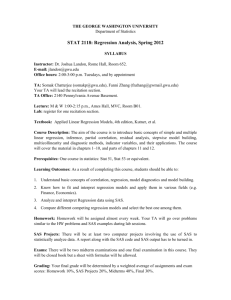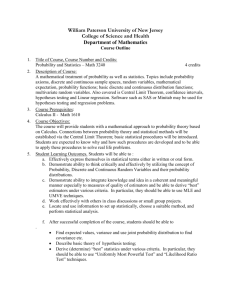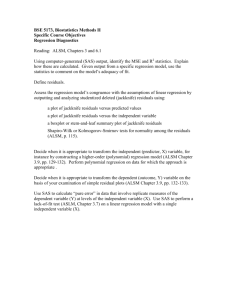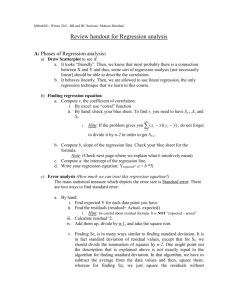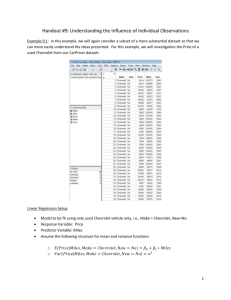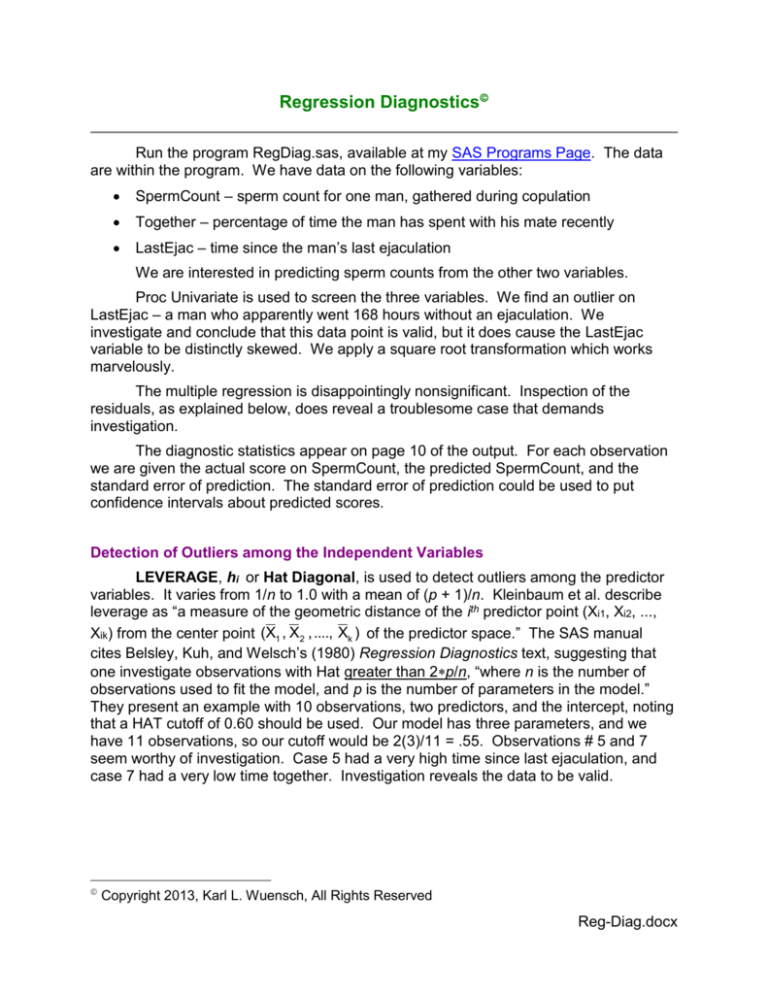
Regression Diagnostics
Run the program RegDiag.sas, available at my SAS Programs Page. The data
are within the program. We have data on the following variables:
SpermCount – sperm count for one man, gathered during copulation
Together – percentage of time the man has spent with his mate recently
LastEjac – time since the man’s last ejaculation
We are interested in predicting sperm counts from the other two variables.
Proc Univariate is used to screen the three variables. We find an outlier on
LastEjac – a man who apparently went 168 hours without an ejaculation. We
investigate and conclude that this data point is valid, but it does cause the LastEjac
variable to be distinctly skewed. We apply a square root transformation which works
marvelously.
The multiple regression is disappointingly nonsignificant. Inspection of the
residuals, as explained below, does reveal a troublesome case that demands
investigation.
The diagnostic statistics appear on page 10 of the output. For each observation
we are given the actual score on SpermCount, the predicted SpermCount, and the
standard error of prediction. The standard error of prediction could be used to put
confidence intervals about predicted scores.
Detection of Outliers among the Independent Variables
LEVERAGE, hi or Hat Diagonal, is used to detect outliers among the predictor
variables. It varies from 1/n to 1.0 with a mean of (p + 1)/n. Kleinbaum et al. describe
leverage as “a measure of the geometric distance of the ith predictor point (Xi1, Xi2, ...,
Xik) from the center point (X1 , X2 , ...., Xk ) of the predictor space.” The SAS manual
cites Belsley, Kuh, and Welsch’s (1980) Regression Diagnostics text, suggesting that
one investigate observations with Hat greater than 2p/n, “where n is the number of
observations used to fit the model, and p is the number of parameters in the model.”
They present an example with 10 observations, two predictors, and the intercept, noting
that a HAT cutoff of 0.60 should be used. Our model has three parameters, and we
have 11 observations, so our cutoff would be 2(3)/11 = .55. Observations # 5 and 7
seem worthy of investigation. Case 5 had a very high time since last ejaculation, and
case 7 had a very low time together. Investigation reveals the data to be valid.
Copyright 2013, Karl L. Wuensch, All Rights Reserved
Reg-Diag.docx
Page 2
Measures of DISTANCE from the regression surface
SAS gives us, for each observation, the raw residual, the standard error of the
residual, and the “Studentized Residual.” The standard error of the residual is
computed as MSE(1 hi ) . The Studentized Residual, also known at the
standardized residual, is simply the raw residual divided by this standard error.
Kleinbaum, Kupper, and Muller (1988, Applied Regression Analysis and Other
Multivariable Methods) note that this statistic approximately follows Student’s t
distribution with n - k - 1 degrees of freedom” (k standing for the number of predictor
variables). Kleinbaum et al. define a standardized residual as raw residual divided by
root mean square.
The values in the column labeled “RStudent” are the Studentized deleted
residuals -- these Studentized deleted residuals are computed in the same way that
standardized residuals are computed, except that: the ith observation is removed before
computing its Ŷi , e i , MSE, and standard error . This prevents the ith observation from
influencing these statistics, resulting in unusual observations being more likely to stick
out like a sore thumb. Kleinbaum et al. refer to this statistic as the jackknife residual
and note that it is distributed exactly as a t on n - k - 2 degrees of freedom, as opposed
to n - k -1 degrees of freedom for the Studentized (nondeleted) residuals. The SAS
manual (SAS/STAT User’s Guide, Version 6, fourth edition, chapter on the REG
procedure) suggests that one attend to observations which have absolute values of
RSTUDENT greater than 2 (observations whose score on the dependent variable is a
large distance from the regression surface). Using that criterion, observation # 11
demands investigation – the predicted sperm count is much lower than the actual sperm
count.
Measuring the Extent to Which an Observation Influences the Location of the
Regression Surface
COOK’S D is used to measure INFLUENCE, the extent to which an observation
is affecting the location of the regression surface, a function of both its distance and its
leverage. Cook suggested that one check observations whose D is greater than the
median value of F on p and n-p degrees of freedom . David Howell ( Statistical
Methods for Psychology, sixth edition, 2007, page 518) suggests investigating any D >
1.00. By Howell’s criterion, observation # 11 has an influence worth of our attention.
The Cov Ratio measures how much change there is in the determinant of the
covariance matrix of the estimates when one deletes a particular observation. The SAS
manual says Belsley et al. suggest investigating observations with ABS(Cov Ratio - 1) >
3*p/n. The Dffits statistic is very similar to Cook’s D. The SAS manual says Belsley et
al. suggest investigating observations with Dffits > 2SQRT(p/n). The SAS manual
suggests a simple cutoff of 2. Dfbetas measure the influence of an observation on a
single parameter (intercept or slope). The SAS manual says Belsley et al. recommend
a general cutoff of > 2 or a size-adjusted cutoff of > 2/SQRT(n). Case number 11 is
suspect here too, with great influence on the slope for time since last ejaculation.
Page 3
We investigate case number 11 and discover that the participant had not
followed the instructions for gathering the data. We decide to discard case number 11
and reanalyze the data. Case number 11 was, by the way, contrived by me for this
lesson, but the data for cases 1 through ten are the actual data used in the research
presented in this article:
Baker, R. R., & Bellis, M. A. (1989). Number of sperm in human ejaculates
varies in accordance with sperm competition theory. Animal Behaviour, 37, 867–
869.
Regression Diagnostics with SPSS
Back to Wuensch’s Stats Lesson Page
Copyright 2013, Karl L. Wuensch, All Rights Reserved



